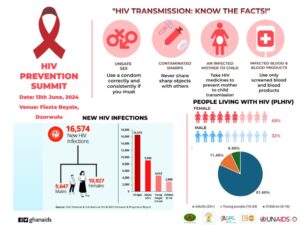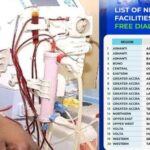According to the Ghana AIDS Commission, an estimated 50 persons get HIV every day.
The majority of the new infections have been identified as persons between 15 and 49 years old, the economically active population. The data announced during the release of the 2023 national and sub-national HIV and AIDS estimates and projections also showed that a total of 334,095 people were living with HIV/AIDS in the country, 17,550 of the number being children below 15 years.
It also indicated that the country recorded 17,774 new HIV infections, with 1,698 being children below 15 years and 16,076 representing adults above 15 years. The data showed that new infections, AIDS deaths and HIV prevalence were declining but not sufficient to achieve the set goals and targets.
However, announcing the statistics at a media engagement to disseminate the results and discuss the implications and enhance understanding of the HIV estimation process to promote ownership of the results among stakeholders, the Director-General of the Ghana AIDS Commission, Dr Kyeremeh Atuahene, said although significant strides had been made in the implementation of HIV interventions, more needed to be done to achieve the expected target.
The forum was attended by media professionals and stakeholders in the HIV response sector.
Regional and district-level data show varying prevalence and new infections, with Greater Accra, Ashanti and Eastern regions having the highest number of persons living with HIV while the districts with the highest HIV population include Accra Metropolitan Area, Kumasi Metropolitan Area and Ledzokuku Municipality.
The commission identified challenges, including data capture, validation, and quality issues, which needed to be addressed expeditiously. In response to a question about the continued occurrence of mother-to-child transmission, Dr Atuahene acknowledged that it was a concern and attributed it to gaps in the healthcare system, emphasising the need for collective efforts to address the issue.
The commission urged stakeholders to work together to achieve the 95-95 targets by the end of 2025, and 98-98 by the end of 2030 and acknowledged the support of stakeholders, including the National AIDS and STI Control Programme, Ghana Health Service, UNAIDS, World Health Organisation, and US President’s Emergency Plan for AIDS Relief (PEPFAR), in generating the data.
The UNAIDS Country Director, Hector Sucilla Perez, whose speech was read on her behalf by the Strategic Information Adviser, Cynthia Amoah Asante, emphasised the importance of understanding the epidemic and using data for action to end AIDS as a public health threat by 2030.
The estimates, Ms Perez said, were crucial for guiding programming for the President’s Emergency Plan for AIDS Relief (PEPFAR) and the Global Fund. She said the Global AIDS Strategy (2021-2026) highlighted a bold new approach to address inequalities that drove the AIDS epidemic and prioritised people who were not yet accessing life-saving HIV services.
Ms Perez also stressed the critical role of the media in advocating the needs of persons living with HIV and improving societal enablers to create an enabling environment.
Ghana’s efforts praised
The Country Director of the US Centre Disease Control (CDC), Tony Ao, commended Ghana’s national efforts in the fight against HIV/AIDS and the progress made towards achieving high-quality data to guide the nation.
He also encouraged stakeholders to use the data judiciously, with technical guidance from experts, to ensure meaningful interpretation and application.
Mr Ao stated the CDC’s commitment to supporting Ghana’s national AIDS response and commended the country’s progress towards achieving the 95-95-95 targets and ending AIDS as a public health threat by 2030.









Leave a Reply